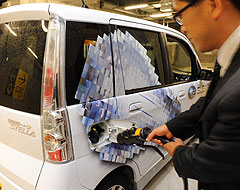Make / Model Search
Future models - Subaru - Stella EVSubaru keeps its cool on EV batteriesSubaru is confident it can beat the heat and lead the (re)charging pack24 Feb 2009 By IAN PORTER SUBARU’S Takaski Suzuki dismisses as “nonsense” the struggles other car-makers are having keeping their lithium-ion batteries cool. “We have no cooling on the Plug-in Stella because our batteries have good heat dissipation,” he said in Melbourne. Other companies have had to devote considerable resources to keeping the batteries in their electric vehicles cool as they are charged and discharged. “Having to cool the batteries is nonsense,” he said. Mr Suzuki said that was one reason why Subaru chose the laminated lithium-ion batteries produced by a joint venture between Nissan and Japanese electronics giant NEC. The batteries are thin and flat and are assembled into modules of 12 cells. Mr Suzuki said the way the cells had been assembled meant the temperature did not fluctuate much, even when the batteries were being charged rapidly.  However, Subaru has designed-in a fail-safe system in case high ambient temperatures combine with heavy use of the Stella to threaten the integrity of some of the other components in the system. However, Subaru has designed-in a fail-safe system in case high ambient temperatures combine with heavy use of the Stella to threaten the integrity of some of the other components in the system.There are several stages in the warning system, starting with a light on the dashboard, which advises the driver to slow down. If heavy use continues, the system will restrict the batteries to 80 per cent of output, and output will be further reduced if there is no drop in speed. The Stella can be recharged two ways. First, a 240-volt household socket in Australia will give a complete charge in four hours. There is also a rapid-charge system using an industrial-strength plug and, Mr Suzuki said, clever Subaru current management systems. This delivers an 80 per cent charge in 15 minutes, good enough for a range of 65km in a cycle driving cycle. He said the rapid charge was done using 400 volt DC current at 100 amps, equivalent to 40kW. “This is an extremely high rate. Only Subaru can recharge this fast,’’ Mr Suzuki said. Subaru chose the lithium-ion batteries, despite their cost. Mr Suzuki said they were selected because they had the best energy density, meaning they contained more energy than other batteries for a given volume inside the car. “Lithium-ion batteries are two-thirds the size of nickel-metal-hydride batteries and only two-fifths the size of lead acid batteries,” he said. He said they were expected to last 10 years, but admitted they were expected to lose about 20 per cent of their storage capacity after six years. He said that, while they could not yet be recycled, it would be possible to apply used car batteries to other storage functions, such as wind farms. Mr Suzuki said electric cars were much more energy efficient than normal vehicles with internal combustion engines. He said that, as little as 15 per cent of the energy in petrol gets to the drive wheels, thanks to heat losses in the engine and mechanical losses as high as 30 per cent in the gearbox and drive train. Even with the heat losses inherent in a coal-fired power station, electric cars ended up well ahead. Mr Suzuki said the power station captured 52 per cent of the energy in coal and sent that into the grid. About 95 per cent of that energy reaches the wall plug in the garage. Of the electricity put into the Stella, 92 per cent of it reaches the wheels, which means that around 45 per cent the energy in the coal that went into the power station actually was used to drive the Stella. The eight per cent loss in electricity in the Stella was due to mechanical losses caused by the single reduction gear and the differential. Read more:First drive: Subaru EV ‘one cent a km’All future models Alfa Romeo Alfa Romeo Abarth Abarth Alpine Alpine Alpina Alpina Audi Audi Aston Martin Aston Martin BMW BMW Bentley Bentley Chery Chery Brabham Brabham Chrysler Chrysler Chevrolet Chevrolet Cupra Cupra Citroen Citroen DS DS Dodge Dodge Fiat Fiat Ferrari Ferrari Foton Foton Ford Ford Great Wall Great Wall FPV FPV Haval Haval GWM GWM Honda Honda Holden Holden Hummer Hummer HSV HSV Infiniti Infiniti Hyundai Hyundai Jaguar Jaguar Isuzu Isuzu Kia Kia Jeep Jeep Land Rover Land Rover Lamborghini Lamborghini Lexus Lexus LDV LDV Mahindra Mahindra Lotus Lotus Mazda Mazda Maserati Maserati Mercedes-AMG Mercedes-AMG McLaren McLaren MG MG Mercedes-Benz Mercedes-Benz Mitsubishi Mitsubishi Mini Mini Opel Opel Nissan Nissan Peugeot Peugeot Pagani Pagani Proton Proton Porsche Porsche Renault Renault Ram Ram Rover Rover Rolls-Royce Rolls-Royce Skoda Skoda Saab Saab SsangYong SsangYong Smart Smart Suzuki Suzuki Subaru Subaru Toyota Toyota Tesla Tesla Volvo VolvoMotor industry news |
Click to shareSubaru modelsResearch Subaru All future models Alfa Romeo Alfa Romeo Abarth Abarth Alpine Alpine Alpina Alpina Audi Audi Aston Martin Aston Martin BMW BMW Bentley Bentley Chery Chery Brabham Brabham Chrysler Chrysler Chevrolet Chevrolet Cupra Cupra Citroen Citroen DS DS Dodge Dodge Fiat Fiat Ferrari Ferrari Foton Foton Ford Ford Great Wall Great Wall FPV FPV Haval Haval GWM GWM Honda Honda Holden Holden Hummer Hummer HSV HSV Infiniti Infiniti Hyundai Hyundai Jaguar Jaguar Isuzu Isuzu Kia Kia Jeep Jeep Land Rover Land Rover Lamborghini Lamborghini Lexus Lexus LDV LDV Mahindra Mahindra Lotus Lotus Mazda Mazda Maserati Maserati Mercedes-AMG Mercedes-AMG McLaren McLaren MG MG Mercedes-Benz Mercedes-Benz Mitsubishi Mitsubishi Mini Mini Opel Opel Nissan Nissan Peugeot Peugeot Pagani Pagani Proton Proton Porsche Porsche Renault Renault Ram Ram Rover Rover Rolls-Royce Rolls-Royce Skoda Skoda Saab Saab SsangYong SsangYong Smart Smart Suzuki Suzuki Subaru Subaru Toyota Toyota Tesla Tesla Volvo VolvoMotor industry news |









Facebook Twitter Instagram